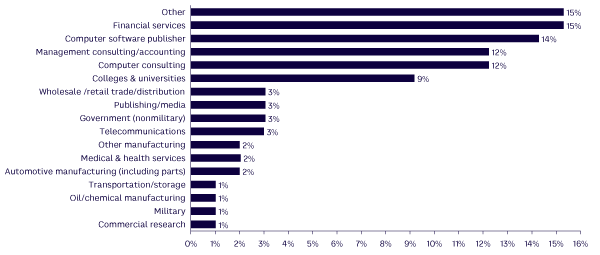AMPLIFY VOL. 36, NO. 8

In its relatively brief existence, generative artificial intelligence (GAI) has both amazed and alarmed, due to its ability to perform tasks previously considered too dependent on human knowledge or creative skills. Today, everyone from rank-and-file employees to managers and CxOs at almost every organization in the world is trying to figure out how to effectively and safely apply the technology.
At the moment, it can be difficult to determine the current status of GAI within the enterprise and what the future holds. To gain insight into these and other important questions, Cutter conducted a survey from April–May 2023 about how organizations are adopting GAI and what they see as the possible impacts on their businesses and industries. We also asked about key trends organizations are encountering, or foresee arising, when adopting the technology.
This article aims to assist organizations’ efforts to leverage GAI by examining some of the findings. Specifically, it covers the following:
-
Current status of GAI in the enterprise and future plans, including the GAI technologies and commercial GAI products organizations are using/planning to use
-
Enterprise adoption of large language models (LLMs)
-
Strategy, oversight, and employee support for GAI adoption and usage
-
Enterprise experience with GAI to date
Our findings are based on the responses of 103 global organizations. Where applicable, we offer anonymous quotes from participants who were kind enough to share their thoughts and experiences with GAI. For more on survey methods, including demographics, see end of article.
GAI in the Enterprise: Current Status & Future Plans
Our first key question considers to what extent organizations are currently using or planning to use GAI. As shown in Figure 1, just under half of surveyed organizations are already using tools like ChatGPT, DALL-E, and Jasper AI. Another 14% indicate they plan to do so within the next six to 12 months. A further 19% report that their organizations are seriously considering its use.
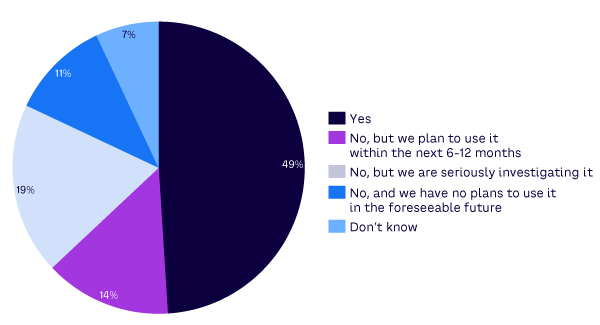
This rate of adoption is, quite frankly, amazing. In my decades of conducting surveys measuring enterprise adoption of advanced and emerging information technologies, I’ve never seen anything like this — certainly not for AI! Although GAI has only been generally available (in the form of commercial products) for about seven months, 81% of respondents say their organizations are either using it, planning to implement it, or seriously investigating doing so. It’s also notable that only 11% of surveyed organizations have no plans to use GAI in the foreseeable future.
Figure 2 provides additional insight into adoption by organizations using GAI. It appears that respondents are somewhat unsure as to how GAI is making its way into their organizations: for the majority, unapproved and approved use of GAI tools is about equal (49% versus 46%, respectively).
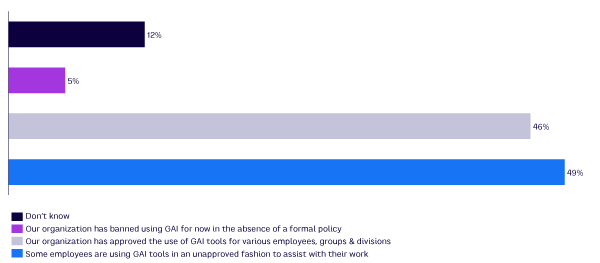
This trend can be attributed to the relative newness of this popular technology. Employees have ready access to a range of GAI-powered writing tools, text-to-image (and other AI art) generators, computer coding, and other programs that are available on a variety of easy-to-use platforms, even mobile devices. Employees are eagerly using them, whether in an official or unofficial capacity, as noted by this executive VP at a manufacturing company:
Individuals are using generative AI to accelerate content generation, but there is no prescribed or designed practice yet.
Other organizations are using GAI tools in a more approved and guided manner, as indicated by this university department chairperson:
Individuals within the organization are using [generative AI]. We are also looking to bring everyone up to speed with AI literacy with professional development initiatives.
Another interesting finding is that, for all the talk in the general press about organizations outright banning their employees (or selective groups of employees) from using GAI (usually due to security considerations around sensitive data, privacy, and intellectual property [IP]), few respondents indicated their organizations have done so.
Note that organizations that do not allow their employees to use GAI tools must recognize the potential loss of productivity gains afforded by the technology, and those allowing it must devise formal policies to (1) regulate its use and (2) capture and document its benefits.
Which GAI Technologies?
The overwhelming majority of organizations in our survey are using basic GAI tools like ChatGPT, Craiyon, DALL-E, and Stable Diffusion. This makes sense, if you consider that most of these tools are free or low-cost. That said, organizations appear open to the possibility of using a range of GAI tools, as noted by numerous respondents and summed up by this chief scientist at a manufacturer:
We are exploring all relevant, available generative AI tools that might be leveraged for the benefit of our organization.
Our research also found considerable interest among organizations in using domain-specific enterprise tools and applications featuring integrated GAI functionality. Examples include Cognigy (contact center), Jasper (marketing), GitHub Copilot (code generation), Kaizen Chat (customer support/chat/email), and Lavender (sales).
However, use of industry-specific GAI enterprise tools and applications is quite limited. Examples include CALA (fashion design), COVU (insurance), and Harvey (legal). Most of these tools are still in development or available only to select customers in beta form. However, some organizations are exploring their use, as indicated by this CIO at a major university:
We are interested in generative AI tools integrated with EDU [educational] platforms — LMS ([learning management systems], plagiarism detection, admissions, and IT service management.
Expect the use of domain-specific enterprise tools and applications and industry-specific enterprise tools and applications with integrated GAI functionality to increase significantly over the next few years. Reasons include: (1) huge interest among end-user organizations and (2) the fact that almost all leading enterprise software providers (SAP, Oracle, Microsoft, Salesforce) and a slew of start-ups are integrating GAI capabilities into a broad range of tools and commercial applications.
Which Commercial GAI Products?
OpenAI’s ChatGPT is the overwhelming tool of choice among end-user organizations using GAI in our survey, followed by Microsoft’s Bing Chat and (a distant third) GitHub Copilot (see Figure 3). This is not surprising because these were the first GAI products to become generally available and were readily adopted by many users in record-setting time. Their adoption was also accelerated by Microsoft integrating OpenAI’s technologies (ChatGPT, DALL-E 2) into its Edge browser and other products (e.g., Office) and by the company’s formidable marketing muscle.
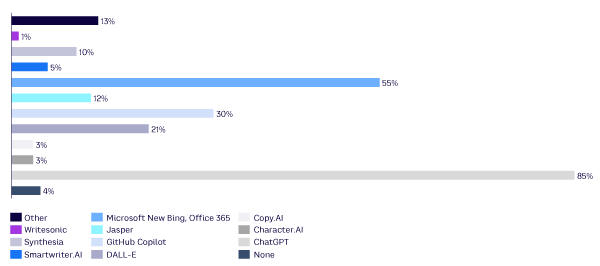
Clearly, ChatGPT (85%) and Bing Chat (55%) are the current leaders when it comes to enterprise GAI use. But a large number of GAI tools are available from a range of vendors, including many start-ups. Organizations appear quite willing to explore these new products, as noted by this business strategist at a financial services company:
ChatGPT has set the early standard, but all relevant generative AI tools are on the table at this stage.
Additionally, although Bing Chat is popular, several organizations pointed out its drawbacks, as commented on by this CEO at a computer consulting firm:
Microsoft's new Bing is useful because it provides access to data that is currently on the Web. However, it is extremely politically correct and otherwise constrained in its answers and, therefore, is far less useful, particularly than ChatGPT-4.
Respondents had the option to indicate other GAI products their organizations are using. Responses included a wide range of tools and commercial applications, including Adobe Firefly, Ask Sage, Google Bard, Anthropic Claude, Databricks Dolly 2.0, Hugging Face BLOOM and StarCoder, Otter.ai OTTER, Mathis Lichtenberger ChatPDF, Microsoft Power BI Copilot, Midjourney, Runway AI Magic Tools, Shutterstock AI image generator, Stability AI Stable Diffusion, and Wonder Dynamics Wonder Studio AI.
Enterprise Adoption of LLMs
Approximately a third of surveyed organizations plan to integrate LLMs into their own applications. Again, this is an impressive rate of adoption, considering that most organizations (outside of tech) have little to no experience working with LLMs. Nearly half of respondents are still unsure about their plans for using LLMs, essentially taking a wait-and-see approach.
Organizations are keenly interested in LLMs because they have proven to improve accuracy in natural language processing (NLP) systems. Moreover, the general availability of LLMs (particularly open source versions) is enabling enterprises, commercial developers, and entrepreneurs to build systems that can perform much more sophisticated NLP tasks.
The caveat is that, for enterprise use, organizations need to train their LLMs on their own data to meet accuracy requirements and avoid the potential for the hallucinations, biases, and other inconsistencies that have so far put a damper on the greater use of LLMs in the enterprise.
This is especially true when it comes to supplementing customer-facing applications like chatbots, conversational interfaces, intelligent assistants, and other self-service customer-assist systems (i.e., automated applications where the output is not first screened for accuracy/correctness by a customer service rep or other human). For these reasons, many organizations are still evaluating LLM applications, as noted by this software engineer/R&D at a telecom company:
We are exploring the use of LLMs. But it all depends on error rates … how reliable it will be, minimizing the risks, and being able to evaluate its responses. Keep in mind, what you are doing is bringing someone else’s software into your organization and exposing its (your organization’s) innermost workings.
We expect to see LLMs integrated into a wide range of proprietary enterprise applications and commercial software products — everything from programming and application development tools to customer service, data integration/access, business intelligence, and cybersecurity environments. This is happening at a furious pace today.
Strategy, Oversight, Supervision & Support
Organizations are currently somewhat lacking when it comes to having a detailed strategy in place for adopting GAI (see Figure 4). This is quite understandable, with the technology being so new. Moreover, new GAI tools appear each day, making planning for adoption a moving target. But this trend appears destined to change soon, as more than three-quarters of responding organizations either plan to implement such strategies within six to 12 months or are seriously investigating doing so. Here is a comment by a IT director in retail:
We are working to create some strategy and guardrails around usage of ChatGPT while exploring business value–driven use cases.
Just 7% of surveyed organizations have no plans in the foreseeable future to develop a detailed strategy for adopting GAI, demonstrating the apparent value that organizations have placed on the technology, as well as the importance of needing to implement strategies to guide its adoption.
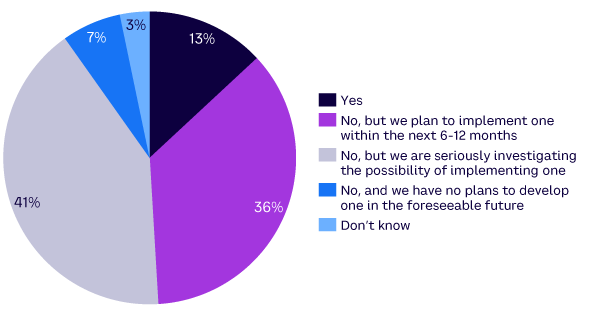
Oversight & Steering of GAI Adoption
Current oversight of generative AI adoption in the enterprise is quite high: more than a third of surveyed organizations (34%) have assigned or created a group charged with overseeing adoption and use of technology within their establishments. Another 42% plan to establish a group within six to 12 months or are seriously considering doing so in the future.
However, almost a quarter of respondents either had no plans to establish a group charged with overseeing generative AI adoption in the foreseeable future or don‘t know the status of such groups in their organizations.
Based on these findings, we expect to see many organizations fleshing out their GAI plans over the next 12 months or so.
Employee Supervision & Support
Current and future plans to support employees with their use of GAI is high (see Figure 5). Nearly 80% of surveyed organizations are either already providing training and other resources to assist employees with using GAI tools within their workflows, plan to do so within six to 12 months, or are seriously considering doing so.
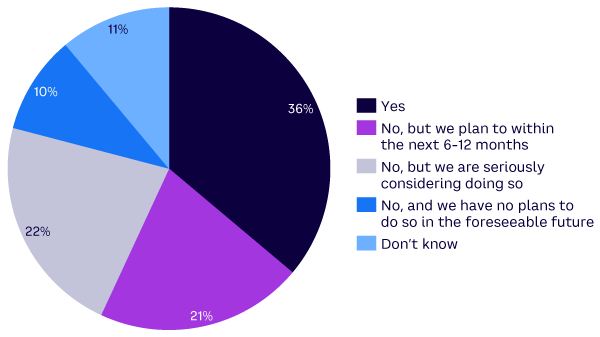
A good example of the kind of support organizations seek to provide employees is offered by this senior manager at a publishing/media firm:
We've got a good governance system that has been developed in the past few months that provides our talent with information on which tools to use, when and how, and for doing what type of work ... all through company accounts that are set up for them to use.
At this stage, we highly recommend providing guidance to employees on the application of GAI tools, particularly on reducing the chance of accidental release of customer data, IP, and other sensitive information.
Enterprise Experience with GAI So Far
One key question around enterprise use of GAI is whether organizations are experiencing benefits from its adoption, including how it is impacting business operations, employee productivity, cost savings, and customer satisfaction.
Measurable Benefits
More than 20% of surveyed organizations are already realizing measurable benefits from GAI. This is impressive, given that most organizations have only been using the technology for a short time. However, 15% have not seen any measurable benefits yet. For the majority of organizations, the jury is still out when it comes to whether or not they are benefiting from the technology.
Transformation of Business Operations
Just over 10% of survey respondents say that GAI use has led to changes in the way the organization or some of its lines of business (LOBs) operate (see Figure 6). However, more surveyed organizations using GAI indicate that its use has not led to any operational changes (16%).
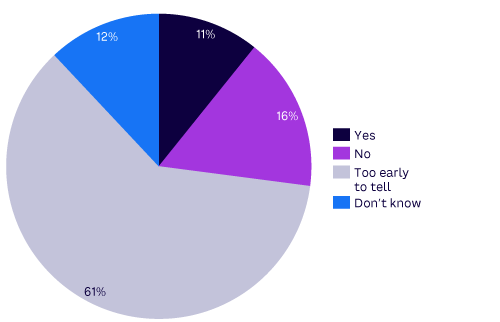
For the majority of organizations currently using the technology (61%), it is simply too early to tell how it is impacting their business operations, as explained by this senior business strategist at an insurance company:
We could be experiencing a transformation today because our marketplace focuses on financial services, and generative AI appears to hold promise in this field, but it is too early to tell how such a transformation is taking shape.
This makes sense since business transformation is typically a complicated undertaking that requires time and a good deal of planning, including determining how to successfully apply a new technology.
Improved Employee Productivity
Our survey indicates that initial enterprise use of GAI has resulted in improved employee productivity at some organizations. In fact, more organizations — almost 30% — report gains in employee productivity through early use of GAI than don’t.
Here are some typical comments about the impact of GAI on employee productivity:
We are not a technology company. We are a nonprofit. It [generative AI] does allow us to do more without having to increase staffing size.
— CEO, nonprofit organization
We are using ChatGPT to help create a book. We are still doing significant editing, and it has been great to have a starting point. It has greatly accelerated our process.
— CEO, management consulting firm
Other respondents report that GAI is benefiting employees in other, perhaps unforeseen, ways, as noted by this VP at a consulting firm specializing in implementing AI solutions:
Happier, more engaged employees. In particular, chatbots provide a naturalistic partner for individuals, for motivation, for job satisfaction, for “emotional” camaraderie, and for being able to ask “dumb” questions without judgment.
Although these early findings appear promising, most organizations using GAI are either still waiting to see how using the technology will impact employee productivity or are unsure at this time.
Cost Savings
So far, surveyed organizations have experienced mixed results when it comes to realizing cost savings from early use of GAI (see Figure 7). The majority (56%) are still waiting to see what happens. This makes sense because cost-savings analyses take time to conduct, and the comments we received indicate that organizations are just now beginning to attempt to measure such savings, as noted by this executive at a communications and media company:
We are doing comparisons that show promise in amplifying the creativity and productivity of our teams in significant ways, which vary depending on the type of job. This is already showing that the use of these tools will lead to significant savings.
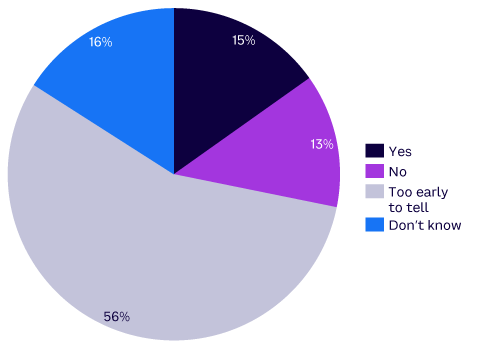
Customer Satisfaction
GAI holds considerable promise for increasing customer satisfaction. For example, by providing highly personalized responses in the form of recommendations and tailored content to customer inquires, GAI could help organizations create more positive experiences that would enhance customer satisfaction. Similarly, R&D departments could use GAI to devise improved products that could lead to more satisfied customers.
However, our research indicates that, to date, organizations have experienced mixed results when it comes to how early use of GAI impacts customer satisfaction. Although some organizations (11%) say their initial use of the technology has had a positive impact on customer satisfaction, most are still waiting to see what happens.
Conclusion
Our research points to a number of important findings about the current/future status and adoption of GAI in the enterprise:
-
Although GAI is very new in the form of commercial products, organizations are rapidly adopting it. Almost half of the organizations we surveyed are using the technology. Future plans for adoption are also high.
-
Adoption of GAI is somewhat haphazard. For the majority of organizations, unapproved and approved use of generative AI tools is about even.
-
Most organizations are currently using basic GAI tools like ChatGPT. But they are also very interested in using domain-specific enterprise tools and applications with integrated GAI functionality.
-
Current use of industry-specific enterprise tools and applications featuring integrated generative AI capabilities is limited. We believe this is primarily due to the limited availability of such products.
-
ChatGPT, Bing Chat, and Copilot are the most popular tools among end-user organizations using GAI. But organizations are eagerly exploring new products as well.
-
Interest in leveraging LLMs in the enterprise is high. About a third of organizations currently plan to integrate LLMs into their own applications.
-
Few organizations currently have a detailed strategy in place for adopting GAI. Expect organizations’ plans to implement such strategies to accelerate considerably over the next six to 12 months.
-
Oversight of GAI adoption in the enterprise is high. More than a third of surveyed organizations have already assigned or created a group to oversee adoption and use of the technology.
-
Current and future plans to support employees with use of GAI are high. Nearly 80% of respondents are either providing training to assist employees with using GAI, plan to do so in the next six to 12 months, or are considering doing so.
-
Some organizations are realizing measurable benefits from GAI. However, this is limited to only about 20% of those surveyed. Most are still waiting to see what benefits the technology will provide.
-
GAI has had a limited impact on business transformation so far. Only 11% of respondents indicate that use of the technology has changed the way the organization or some of its LOBs operate. For most, it’s too early to tell.
-
Enterprise use of GAI is improving employee productivity. Nearly 30% of surveyed organizations indicate this is the case.
-
Organizations have experienced mixed results when it comes to costs savings from initial use of GAI. Most are still waiting to see what happens.
-
Initial use of GAI has had a limited impact on customer satisfaction. However, for most organizations, it is too early to tell how the technology is affecting their customer-satisfaction efforts.
-
Banning GAI tools outright in the enterprise is rare. Organizations should carefully consider before implementing such bans to avoid missing out on employee productivity gains and other possible benefits from using the technology.
Survey Demographics
Our findings are based on the responses of 103 worldwide organizations of various sizes. Fifty-two percent are headquartered in North America, 25% in Europe, 9% in the Middle East, 7% in India, and 4% in Asia/Australia/Pacific, with the remainder in Africa and South America.
Responding organizations’ annual revenues vary, with 8% having annual revenues of more than US $50 billion, 11% between $10 billion and $50 billion, 14% between $1 billion and $10 billion, 20% with more than $50 million to $1 billion, and the remaining 47% with annual revenues less than $50 million. Figure A below shows responding organizations broken down by industry.
